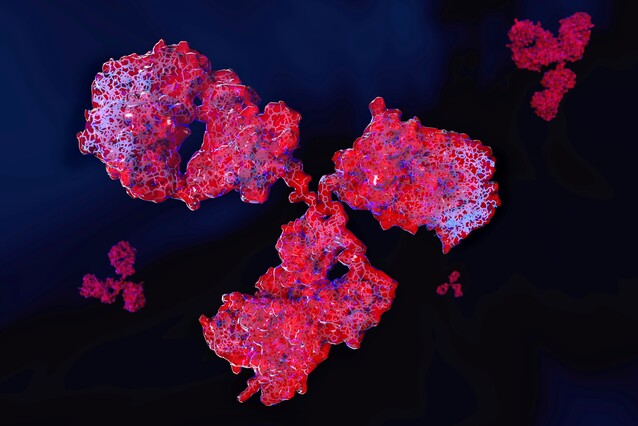Two different DNA folding principles generate antibody diversity
To defend our bodies against infections, we build a seemingly infinite variety of antibodies. Understanding how this can be achieved on a molecular level is a key question in immunology. Scientists from the lab of Meinrad Busslinger now found a new principle underlying the generation of a highly diverse antibody repertoire. Their findings were published in the journal Nature Communications.
To fight infectious agents such as bacteria or viruses, we rely on an immensely wide repertoire of different antibodies. The molecular mechanisms that lead to the formation of these antibodies in B-cells are an important field of immunology research. It is estimated that the human genome can generate up to 1011 different antibodies, which exceeds the number of our 20,000 genes by many magnitudes. This clearly shows that the generation of a broad antibody repertoire requires an additional “diversification machinery”.
The highly variable antigen-binding site of an antibody molecule is formed by a heavy chain and a light chain, which together build the binding surface for disease-causing antigens. Both of these chains are important for recognising pathogens and kicking off an immune response. Antibody heavy and light chains are assembled from individual gene segments by recombination, which takes place at different stages during early B cell development.
In 2020, scientists from the lab of Meinrad Busslinger reported that the prolonged extrusion of DNA loops allows different antibody gene segments of the immunoglobulin heavy-chain (Igh) locus to meet each other in the three-dimensional space of a B-cell nucleus to undergo recombination. The upstream part of the Igh locus contains 200 so-called V gene segments that are spread over a long distance on the DNA molecule. All these V gene segments participate in a recombination process, in which they physically interact with another gene segment in the downstream part of the Igh locus. The interactions of these elements are achieved by folding the locus into a large DNA loop through the interplay of cohesin and its release factor Wapl, which is downregulated by the transcription factor Pax5.
Once recombination of the Igh locus has been completed, B cell development proceeds to the next stage, where recombination occurs at the immunoglobulin k (Igk) light-chain locus, encoding the light chain of the antibody molecule. While studying Igk recombination, the scientists realised that the Igk locus forms multiple small loops, which promotes recombination of all its V genes. This shows that two different DNA folding principles operate at the two immunoglobulin loci, as V gene recombination depends on prolonged DNA looping at the Igh locus and on multiple small loops at the Igk locus.

Figure 1: Two different DNA folding principles operate at the two antibody loci: V gene recombination depends on prolonged DNA loop extrusion at the Igh locus (blue), encoding the antibody heavy chain, and on multiple small loops at the Igk locus (green) coding for the antibody light chain.
The discovery of this folding principle at the Igk locus was now reported in the Journal Nature Communications. It allows light-chain recombination to occur in a nuclear environment that does not support prolonged loop extrusion at the heavy chainlocus. In this way, it prevents further recombination of the heavy-chain locus and thereby ensures that no B cell expresses antibodies with specificities for two different antigens.
“The Igk recombination mechanism that we found provides a nice explanation why B cells generate only one antibody by preventing recombination of the second, non-rearranged Igh locus during Igk recombination,” says Meinrad Busslinger. “In a follow-up, we will now aim to find genetic evidence for this hypothesis.”
In addition to the significance for understanding antibody diversity, the scientists emphasise the fundamental scientific importance of their findings. “It is exciting to discover a mechanism that relates to so many different fields,” says Louisa Hill, a former Vienna BioCenter PhD Student and first author of the study. “Our findings will be of great interest not only for scientists working in immunology, but also gene recombination and chromosome biology.”
Original Publication
Louisa Hill, Gordana Wutz, Markus Jaritz, Hiromi Tagoh, Lesly Calderón, Jan-Michael Peters, Anton Goloborodko, Meinrad Busslinger (2023). “Igh and Igk loci use different folding principles for V gene recombination due to distinct chromosomal architectures of pro-B and pre-B cells”. Nature Communications, doi.org/10.1038/s41467-023-37994-9
About the Vienna BioCenter PhD Program
Much of the work underlying this publication was done by doctoral students of the Vienna BioCenter PhD Program. Are you interested in a world-class career in molecular biology? Find out more: https://training.vbc.ac.at/phd-program/
About the IMP at the Vienna BioCenter
The Research Institute of Molecular Pathology (IMP) in Vienna is a basic life science research institute largely sponsored by Boehringer Ingelheim. With over 200 scientists from 40 countries, the IMP is committed to scientific discovery of fundamental molecular and cellular mechanisms underlying complex biological phenomena. The IMP is part of the Vienna BioCenter, one of Europe’s most dynamic life science hubs with 2,650 people from over 80 countries in six research institutions, two universities, and 40 biotech companies. www.imp.ac.at, www.viennabiocenter.org
